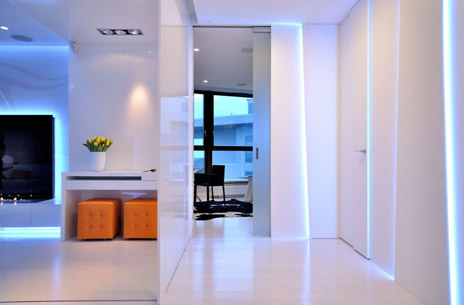 Lighting methods used in modern interior architecture. They can be divided into two groups – The first is the so -called. direct lighting, the other – indirect with the so -called. architectural lighting. Traditional apartment lighting with hanging lamps, chandeliers and wall lamps can be included in the first group. Indirect lighting, giving the possibility of interesting, original solutions is another field for DIY. For example, instead of hanging in the middle of the ceiling random in the form of a chandelier, You can illuminate the room with dispersed light, Building a ramp on the edge of the ceiling (artificial cornice), behind which the luminaires are hidden.
Lighting methods used in modern interior architecture. They can be divided into two groups – The first is the so -called. direct lighting, the other – indirect with the so -called. architectural lighting. Traditional apartment lighting with hanging lamps, chandeliers and wall lamps can be included in the first group. Indirect lighting, giving the possibility of interesting, original solutions is another field for DIY. For example, instead of hanging in the middle of the ceiling random in the form of a chandelier, You can illuminate the room with dispersed light, Building a ramp on the edge of the ceiling (artificial cornice), behind which the luminaires are hidden.
In the hallway, The bedroom or living room can be made "a glowing ceiling" in the form of a suspended ceiling (from matt glass, light fabric or light openwork wooden structure) in advance. Similarly, the wall with an exposure of paintings or plants and a wall with windows is illuminated from behind., hiding the light source behind the curtain rod, so that "glowing curtains" are obtained as a result.
Good results are also obtained by highlighting shelves, shelves, mirror panes, etc.. Indirect lighting is also low -greenery headlights, hidden between sculptures or installed on the floor behind the sofa, armchair or other furniture. The choice of way of lighting the apartment belongs to the home designer, Just like the choice of the type of light sources, luminaire, lamp shapes. In the competition, the glow light versus fluorescent. Fluorescent lighting, Although economic and trouble -free, has a cool color. Meanwhile, the light in the residential interior should create a heat mood, coziness, security. Hence, cold foolish lighting should only be used in utility rooms, in which good lighting is required during the classes (np. Above the worktop in the kitchen, Above the sink in the bathroom). In other rooms, the light of traditional bulbs makes a more favorable impression.